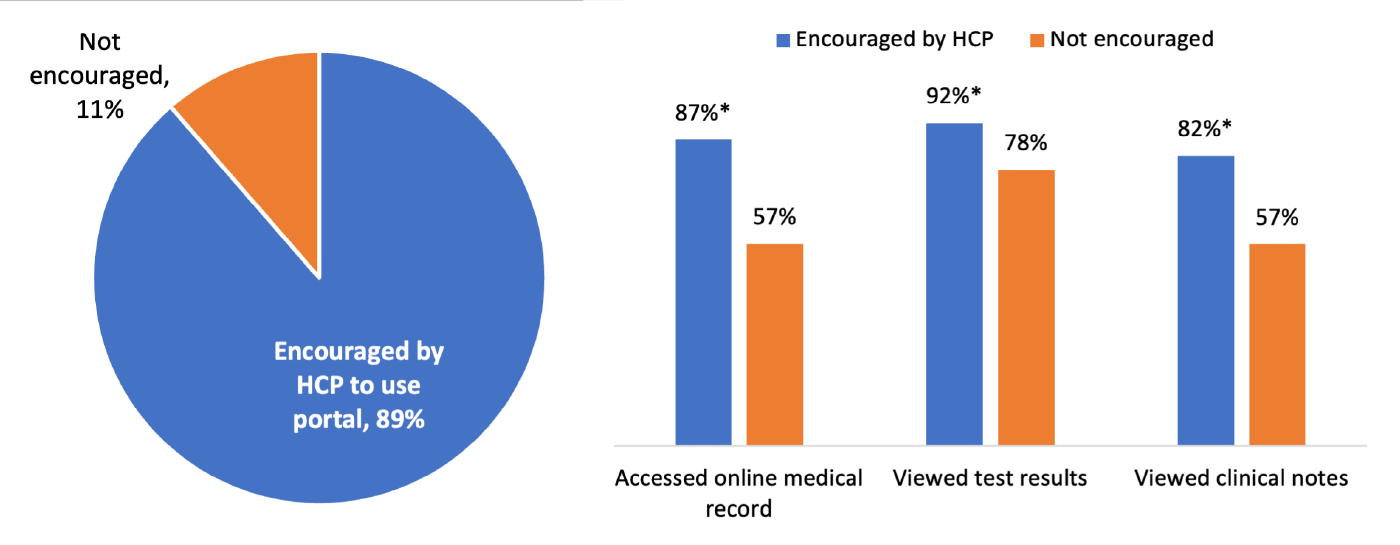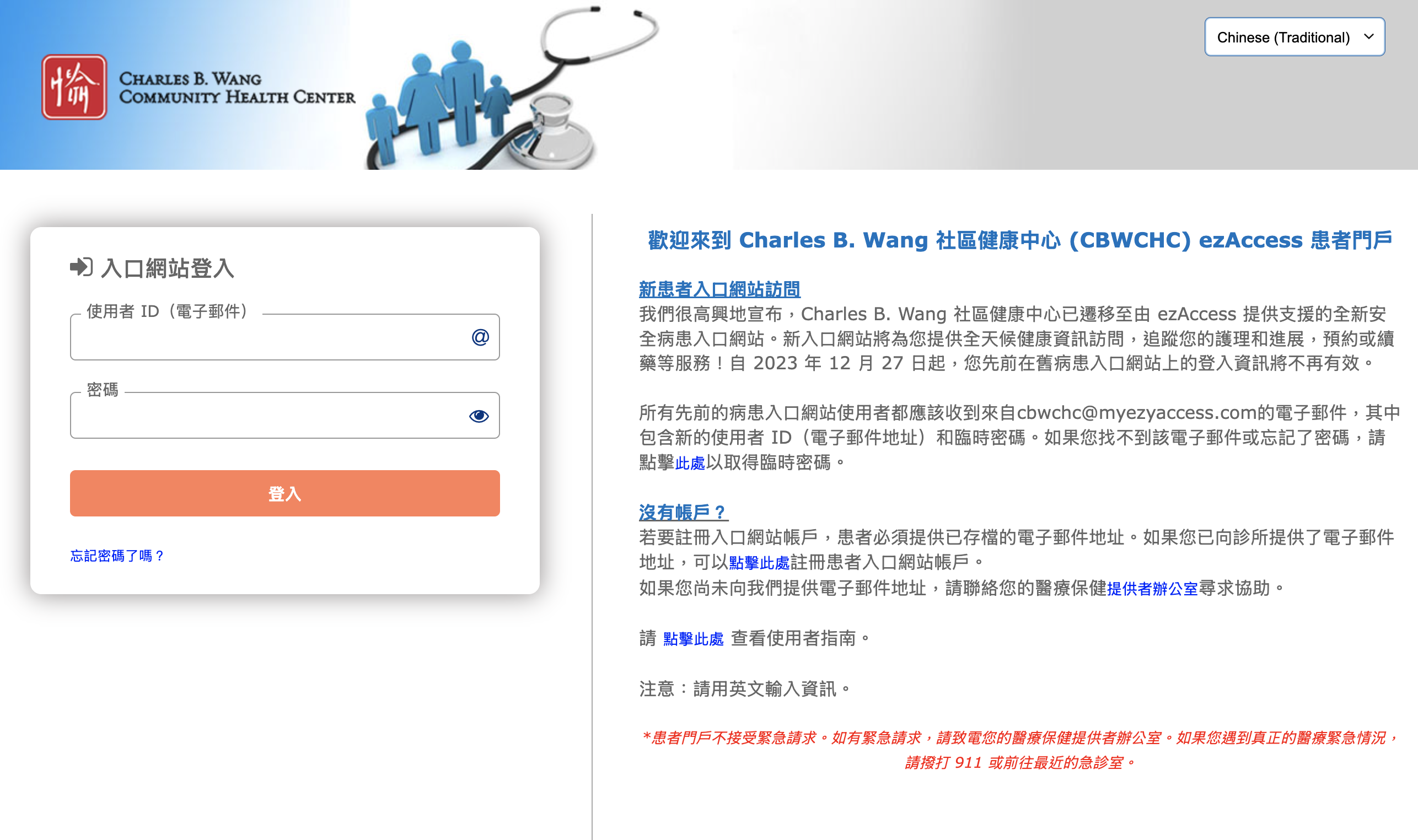Chapter 3
Ensure all patients can access and understand information
In this chapter
Learn how to:
- Take steps to ensure your portal is accessible for all patients and encourage them to use it
- Address adolescent health and privacy concerns in the context of relevant state laws
- Support non-English-speaking patients by providing materials and communication channels in their preferred language
Patient portals can be a powerful force in patient engagement — but it's important for them to be inclusive and accessible. In 2017, nearly 1 in 5 individuals who were offered access to their online medical record but didn't view it said they didn't have a way to access the website. 46 It's also important for health care providers to actively encourage patients to use their portals. In 2024, individuals who were encouraged to use their patient portals to access their online medical record did so at a much higher rate — over 50% higher — than individuals who were not encouraged. 47
Depending on your patient population, trouble accessing or using the patient portal can contribute to health disparities — preventable differences in health outcomes between groups of people that are closely linked with social, economic, or environmental disadvantages. For example, if a portal's medication refill reminders are only available in English, patients with limited English proficiency may be less likely to get the medications they need to manage chronic conditions.
When setting up your portal, take steps to ensure that it meets the needs of all your patients.
3.1 Ensure portal access for all patients
To support all patients in accessing their health information, you can:
- Offer your patient portal in multiple languages
- Make sure your portal is mobile-friendly and that the pages load quickly, so that users with limited data or slow connections can still access it
- Check that your portal is easy to navigate for patients who use screen readers or other assistive technology
In 2024, most individuals (57%) used smartphone health apps to access their online medical records, while many (42%) only used web-based access through their patient portals. 48
Keep in mind, simply offering patients access to a portal isn't enough — actively encouraging them to use it is key to ensuring they access their online medical records, review written instructions or clinical notes, and view test results. As the figure below shows, patients are much more likely to be engaged and use your online services when you encourage them to do so. 49
Within the portal, you can also capture information that helps your staff provide culturally and linguistically appropriate care — such as data fields indicating patients' preferences.

Notes: Denominator represents individuals who were offered access to their patient portal by a health care provider or insurer. ^Denominator for specific uses of a patient portal is among those who accessed their portal at least once in the past year. *Indicates statistically significant difference from reference category (p<0.05).
Make sure caregivers have patient portal access
For patients who are unable to access or use their portal (due to factors like limited cognitive function, lack of education, or inexperience with technology), family members or friends are essential members of the care team. 51
Take steps to allow portal access for caregivers while acknowledging both the diverse roles caregivers can play and patients' varied needs and desires. In 2024, over 50% of caregivers accessed the patient's online medical record when offered access, a figure that doubled between 2020 and 2024. 52
The NewYork-Presbyterian Portal Help Desk | From the field
NewYork-Presbyterian (NYP) implemented a support service to help patients overcome common challenges to using their patient portal. After launching the MyNYP patient portal in 2009, NYP looked for ways to help patients make the most of it. In 2012, the organization launched a Help Desk for patient portal users [PDF - 414 KB] to provide added support.
Four full-time staff provide support in English, Spanish, and Chinese, fielding 120 to 160 requests each week. They solve technological issues, help patients who struggle to find information on the portal, and address common errors in a patient's profile.
NYP established clear standards for responding to requests. Staff members typically respond to patients' online requests in 1 to 2 business days — and make every effort to resolve the issue at first contact by working with other hospital departments as needed, rather than referring patients elsewhere. For example, if a patient is looking for information that typically isn't available on the portal (like sensitive health information), the Help Desk works with the Medical Records department to upload that data to the patient's record.
After making updates to the portal, Help Desk request complexity increased, while the total number of requests decreased. This observation suggested that NYP increased patient engagement by offering additional, comprehensive portal services.
The MyNYP Help Desk experience highlights several key strategies for effective patient portal support:
- View the portal as a patient engagement tool, not just an information technology (IT) solution
- Set clear response standards to ensure consistent, high-quality support
- Resolve issues directly, and at first contact when possible, rather than redirecting patients to other departments
3.2 Address adolescent health and privacy concerns
For adolescent patients (ages 12 to 17), setting up varied levels of portal access can be particularly tricky. Adolescents may want to keep their health care decisions and medical information private, but laws vary from state to state.
Some state laws allow minors to receive specific kinds of health care, like mental or sexual health services, without their parents knowing or consenting. Others say that minors can make decisions on their own if they have an “adult status,” like being married or in the military. 53
Parents may also want to keep certain information, like a family history of disease, between only themselves and their adolescent's provider.
Variance in state adolescent consent and privacy laws 54 | From the field
A 2022 study published in Pediatrics found wide variation in state laws on adolescent health consent and privacy, which may create challenges for health systems providing adolescent-specific patient portal access. Services reviewed included mental health care, sexually transmitted infection (STI) treatment, contraception, substance use care, and HIV services.
Key findings from the review:
- No 2 states had the same set of laws covering adolescent services.
- Some state laws don't fully align with the American Academy of Pediatrics' recommendations for evidence-based adolescent care.
- State variation can limit how health IT systems manage adolescent privacy, such as which records teens can see and what information parents can access.
Health systems must navigate these differences — which may continue to change — and thoughtfully balance legal requirements, patient engagement strategies, and recommended standards of care when implementing patient portal features and updates.
Adolescent MyChart 55 | From the field
The University of California at San Francisco (UCSF) has customized MyChart — the patient portal offered through their electronic health record vendor, Epic — to offer appropriate patient and representative access that meets Meaningful Use requirements. The result is Adolescent MyChart.
Adolescent MyChart gives each audience access to distinct portal information.
| Content | Adolescent (12-17 years) |
Parent Proxy (≥12 years) |
Parent Proxy (0-11 years) |
|---|---|---|---|
| Labs | YES | YES | YES |
| Immunizations | YES | YES | YES |
| Allergies | YES | YES | YES |
| Growth Chart | NO | NO | YES |
| Messaging to and from provider | YES | YES | YES |
| Appointment Request | YES | YES | YES |
| Appointment View | YES/NO* | YES/NO* | YES |
| Problem List/Summary | NO | NO | YES |
| Medications/refill request | NO | NO | YES |
| Goals | YES | YES | YES |
| Care Team Members | NO | NO | YES |
| Social History | NO | NO | YES |
| Vital Signs | NO | NO | YES |
| * Teens and Teen Proxy can see only non-sensitive future and past appointments. For non-sensitive past appointments, the teen and proxy will be able to see notes, including patient instructions, but not the AVS. | |||
At UCSF, parents have limited portal access to potentially sensitive information about their teen children. This lines up with California law, which allows teens between ages 12 and 17 years to keep care for medical needs like STI testing, contraception, and pregnancy care private. For example, parents can't access lab results from a pregnancy test or obstetric ultrasound.
Through Adolescent MyChart, UCSF can more successfully engage teens in their care while also protecting their privacy.
3.3 Engage non-English-speaking patients
As you're developing and improving your patient portal, it's important to be inclusive and accessible to non-English-speaking patients as much as possible. According to the U.S. Census Bureau, 22% of individuals age 5 years and older speak a language other than English at home. 56
To support non-English-speaking individuals in your patient population, you can: 57
- Use the portal landing page to make materials available in languages spoken by your patients
- Enable your system to send text messages to patients in their preferred language, either as part of the portal or as a stand-alone functionality
- Let patients know they may send secure messages to their provider in their native language — if you have workflows developed to translate and respond to these messages
Charles B. Wang Community Health Center (CBWCHC) | From the field
Since December 2013, the CBWCHC patient portal has provided services in Traditional Chinese in addition to the Center's original English platform. The platform is now also available in Spanish and Korean.
Before launching, an interdisciplinary project team collaborated to develop and review the portal, ensuring that it was easily accessible, culturally sensitive, and supportive of positive health outcomes.
“Promoting patient engagement through tools such as linguistically-appropriate patient portals is a key step for maintaining the importance of individual patient needs in receiving care services.”
— Lynn Sherman, MBA, Chief Financial Officer at the Charles B. Wang Community Health Center
Chapter 3 Recap
Look for opportunities to make your patient portal accessible and secure for all users.
- Take steps to ensure your portal is accessible for all patients and encourage them to use it
- Address adolescent health and privacy concerns in the context of relevant state laws
- Support non-English-speaking patients by providing materials and communication channels in their preferred language
Content last updated on: August 14, 2025

